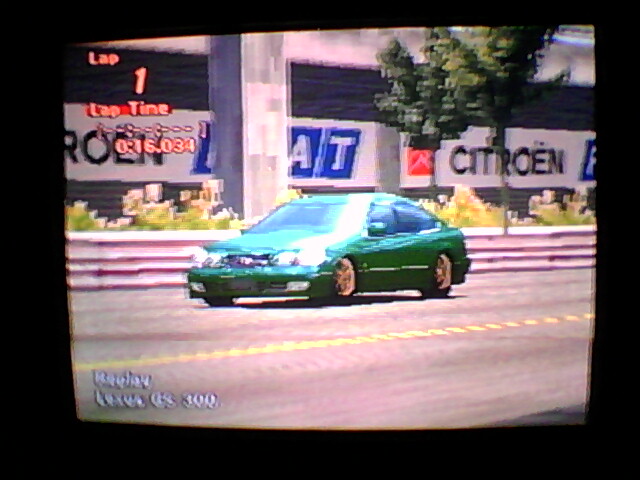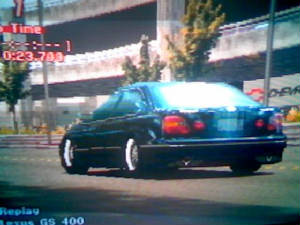|
Years Represented: 1991-2000
Class: Mid-size Luxury Car
Type: 4-door sedan
Country: Japan ``````````````````````````` Host: GT2, GT4, & GT5
Price: $39,740 ('97 GS 400. GT2 new car lot)
$16,589 ('91 GS 300. GT4 used car
lot)
$44,200 ('00 GS 300. GT4
new car lot)
$45,500 ('00 GS
300. GT4 new car lot--Vertex Edition)
$33,029
('00 GS 300, GT5 used car lot)
GT5 Mileage: 31,591.2
*dimensions below for 2nd-generation GS300 or
400
Length: 189" // Width: 71" // Height: 56"
Wheelbase: 110"
Track: 60.4" [F] 59.4" [R]
Overhang: @6 feet 3
inches
Ground Clearance: 5.3"
Weight: 3,692 lbs.
Wgt. Distribution: 54/46
Tires: varies. could be P235/45ZR-17 or P255/55VR-16
Brakes: vented discs
Suspension: double wishbones / coils / shocks / anti-roll bars
GS 300 Engine: 3.0 liter DOHC inline-6 (first gen)
Aspiration: twin-turbo
Fuel System: ?
Valves / Cyl: 4
Bore x Stroke: 3.39" x 3.39"
Compression: 8.5:1
Final BHP: 287 @ 5,600 rpms
Fnl. Torque: 330 @ 3,600 rpms
Credits per HP: $57.80
Pounds per HP: 12.90
HP per Liter: 95.8
Idle Speed: 550
// Redline: 6,500 // RPM Limit: 7,000
* An oil change (but no engine rebuild) was performed on the GS300 of
GT5
GS 300 Engine: 3.0 liter inline-6
Aspiration: normal (in theory)
Fuel Syst:
PFi
Valves / Cyl: 4
Bore x Stroke: 3.39 x 3.39"
Compression: 10.5:1
Final HP: 281 @ 5,500
Fnl
Torq: 341 @ 3,500
Credits per HP: $117.54
Pounds per HP: 13.18
Pnds per Torq: 10.86
HP per
Liter: 93.7
GS 400 Engine: 4.0 liter DOHC V8
Aspiration: normal
Fuel
System: PFi
Valves per Cylinder: 4
Bore x Stroke: 3.44" x 3.25"
Compression Ratio: 10.5:1
Tested HP: 303 @ 6,000 rpm
" Torque: 310
@ 3,900 rpm
Credits / HP: $131.15
lbs per HP: 12.18
HP per Liter: 75.75
Redline: 6,500 // RPM Limit: 7,000
GT2
Transmission: 5-speed automatic
GT4 Transmission: 4-speed automatic
GT5 Transmission: 4-speed automatic ('00 GS 300)
Layout:
Front Engine / Rear Drive
Differential: limited-slip (option on some models)
*all track testing currently
for GS400 in GT2, '91 GS300 of GT4, and '00 GS 300 of GT5
0-60 mph:
GT2: 5.8 seconds
GT4: 6.1 "
GT5: 6.379
0-100mph:
14.3 seconds
14.766 "
15.189
0-150mph:
no test
44.xxx secs
56.883 (Daytona)
400 M:
GT2: 14.509 @ 100 mph
GT4: 14.618 @ 99 mph
GT5: 14.839 @ 98 mph
1/4 Mile
GT5: 14.892 @ 98 mph
1 KM
25.762 @ 132 mph
26.092 @ 129 mph
26.499 @ 127 mph
1 Mile
GT5: 36.582 @ 141 mph
Test Track:
GT2: 1:45.989
GT4: 2:22.208
GT5: 58.455 (Daytona)
100-zero mph:
GT2: no test
GT4: 3.94 secs
GT5: 5.433
Top Speed at Redline
1st: 36 mph
2nd: 60 mph
3rd: 91 mph
4th: 120 mph
5th: 162.3 mph
Top Speed at Redline
1st: 44 mph
2nd: 84 mph
3rd: 130 mph
4th: 165.87 @ 5,800 rpm
Top Speed at Redline
1st: 42.8 mph
2nd: 81.6
3rd: 126.7
4th: 165.0 mph @ 5,900 rpm

---------------EXTERIOR---------------
For all of you who thought Lexuses (Lexi?) are solely for corporate/yuppy types, think again. This 4-door
may look like your podiatrist's ride to the golf course, but it packs some serious machinery under its skin.
If
you've got the credits to afford a Lexus GS, it means you're doing pretty good. Being a middle-ground luxury car made for
white-collar types, it isn't something someone would buy if they were struggling with money, in real-life or in the games.
GT2 features two models: the GS300 and GS400 (a straight-6 and a V8, basically). Both can be found in GT2's
new car lot, located in the East City, which deals solely with Japanese cars.
By the time GT4 was released, things
changed a bit. GT4's GS cars boast several inconsistencies, so this part gets me confused...
First inconsistency. We can buy a used 1st-gen GS 300 from GT4's early-'90s lot, but it's an earlier
1991 model with a straight-6 twin-turbo, rather than a naturally-aspirated straight-6 or V8 as in GT2. Okay, I get that,
no prob. In America, we didn't get turbocharged GS cars for whatever reason. But oddly, the two GS300s
in GT4's new car lot (both of them 2nd-gen) can be modified with turbos only, unlike the GT2 GS300, which
can accept natural power only. Huh?!?
...Also, these GS sedans can only be found in the American lot (not the
Japanese one) even though they are basically just Japanese cars built in America. Uhhh? And we
can't race a Lexus in any Japanese events, even though the GS is based on and in many ways similar to the Japanese Toyota
Aristo. Wha? But we CAN drive a Lexus IS in Toyota's Altezza Cup. :confused: To further this
confusion, how is it possible to race an Acura in Honda's Type R and NSX races, even though Acura is the American brand
of Honda?
GT5 continues the madness, but I'm starting to get bored with PD and their apparent lack of making
sense. Bottom-line: I know most of you won't care about any of this. For some reason I find it interesting.
We
can buy only Lexus GS300s in GT4, not the V8-powered GS400. I'm not sure if V8-powered GS cars appear in GT5 yet
or not. I'm thinking "Not". Anyways, there are two versions of the 300: a base model and a "Vertex Edition" model, which
is supposed to include extra equipment (body parts like the trunk-wing), slightly larger wheels, and suspension parts
not found on the regular version.
As I said earlier, In GT2 the Lexus GS basically equates
to the Toyota Aristo if you want the pure Japanese version rather than the Americanized Lexus. These can be
found as new cars in GT2 (in the Japanese section), but they can not be found in GT4 or 5 unless you have the Japanese
or PAL version I think. Confusing.
There are two other variations of this car, by the way: the ES and the
LS. The ES is a front-drive, and does not appear in any GT game to date. Neither does the LS, which is rear-drive, more
luxurious and cooshier version. The GS is the one for drivers who want just a bit extra performance.
As
said before, the style of these cars are rather sedate. The first-generation GS was designed by Italdesign
Giugiaro, but later 2nd-gen models were designed soley by Toyota. Either version copies the lines of the Mercedes
E-class and BMW 5-series sedans, but at a cheaper cost. One thing the Japanese are good at is figuring how do to things at
a cheaper cost. :)
The complicated front grille and lighting design is aerodynamic and artsy-fartsy at the same time,
and the rear of the car has something going on too; which is why the car has downforce figures of .15 and .25 in GT2
(slightly higher than normal for a sedan). There are several colors available for the GS. None of them are too flashy, since
real-life Lexus clientele usually don't demand flashiness, but there are eight colors; hopefully something for everybody.
These cars weigh-in at around 3,700 pounds, so a good thing to do is shave all that can be shaved.
But honestly, I've won plenty of races in fully-weighted GS cars (no weight redux), and we'll find out why later. In GT2,
both the GS and the Aristo can get race-modifications.

--------------ENGINE / DRIVETRAIN------------
What happens when you cross a small-block DOHC straight-6 or V8 engine with a brain? Well the result can be
found in most of these Lexuses (the 2nd-generation ones, anyways), which mate Toyota's WFi electronically controlled
variable engine computer in cars made after 1997.
The first-gen Lexus GS 300 (GT4/5) with its straight-6
doesn't have as much technology here, but is also no slacker. This is, after all, the same powerplant as can be found
in MA70 Supras, and packs two turbos that guarantee power anytime we step on the gas.
In later cars, the WFi is not the same computer that we buy from the aftermarket. Still, a top-model
Lexus GS 400 in GT2 with a stock engine wallops to 60 mph in only 5.8 seconds...100 follows
in 14.3, so standard equipment must be doing something right. Real-life tests by www.Edmunds.com
create 5.4 seconds to 60 mph, and 14.0 to 100 mph, but these runs were probably done by letting on the gas at higher
revs than I use in my tests. Still, that's pretty accurate, huh? At the Test Track, I achieved 162 mph,
with a bit of room left on the tach for more in a GS400. This is a bit on the high-side when compared to real-life.
In GT2, it's noticeable how little tire smoke this car creates with full Stage 3 power, even with no limited-slip
differential or traction controls. Now in GT4 or 5, be prepared if you're not using driver aids, as you'll now bear witness
to plenty more smoke.
Unlike some other brands, Lexus has a habit of giving us some decent power, but packaging it with rather under-stated
lines; hence the GS series doesn't appear (at first) any more threatening than the lesser ES or LS cars. In
comparing the GS 300 to the 400 in GT2, the straight-6 300 is more throttle-friendly and easier to command when
driven stock than the larger V8, but also not a slow-poke in the acceleration department since it has 234 horsepower
at 6,400 rpm and 224 ft-lbs. at 4,000. In my GT2 testing with this car, 0 to 60 is staked in 6.8
seconds and the quarter mile in 15.0. From here on up, the straight-6 starts to tire, but still
hit a respectable 159 miles per hour around the Test Track even though it only has a 4-speed.
The
earlier '91 GS300 found in GT4's Used Car Lot packs even more power, as do both new-lot cars, since they have
twin turbos and boast 287 hp or more. Again, this is another PD goof, since GS cars are supposed to be "American", which means
they're supposed to be naturally-aspirated, which means they're supposed to have power equivalent to the GS300s from GT2.
Okay....not that I'm complaining or anything, I just like pointing out all these inconsistencies.
Needless to say, you'll rarely hit any GS car's peak in intermediate or beginner's races. Engine mods can wait
while other parts of the car are fixed-up first (and believe me, you'll need to fix other parts first), unless you're
rolling in dough. In GT4, both newer GS models can receive all 4 turbo stages, pushing power up past
600 bhp!
Any of those aftermarket gearboxes will do fine, but I'd steer clear of the super-close one (GT2 only)
because it will sacrifice top-end speed for not much extra acceleration. These engines are all torque monsters anyways. The power-band is wide for any GS, even straight-6 versions. These engines (straight-6 or V8) create most of their
torque at the lower to mid area of the tachometer (3,500 to 5,500 revs). They scream off the starting line,
smoking tires and over-revving straight to their 7,000 rpm rev-limit if the driver's not careful. If you've got a
full-racing gearbox, make sure to take advantage of this mid-range torque when setting 4th and 5th gear. It makes everything
else come together.
And just because this 'podiatrist's ride to the golf course' is packing power, don't assume that's all
it's packing...
-------------------CHASSIS / HANDLING----------------
All right everyone, let's get ready to wallow!!!!! Under the car lies the weakest area of this
luxury bohemoth's performance, but mostly it's all that weight above that's at fault. First the good stuff: when stock,
the 2nd-gen GS cars boast spring rates of 5.5 kg/mm up front and 3.4 rear. That's higher
than what you'd normally find in a mid-size luxury sedan. Lexus was obviously going for a firmer ride, but not too firm. They
wanted to be "sporty", like the E-class Benz and BMW 5-series Lexus, both of which Lexus is obviously competing against.
110 inches of wheelbase and about 60" of track front & rear don't hurt either; giving the GS
a stable platform to ride on, especially once it's at speed. At smaller tracks, however, there are some issues.
Standard
in each 2nd-gen Lexus, and many other Toyota products, is Vehicle Skid Control (VSC). This
system tries its best to bring a skidding or sliding car under control. Problem is, it was developed for highway
driving, not actual racing! The VSC computer chip will seemingly burn to a crisp at a track like Autumn Ring,
Laguna Seca, or Grindelwäld... or any other race longer than two laps for that matter, because the GS (with its
long wheelbase) doesn't maneuver as quickly on tight tracks, and prefers longer braking distances like a true tourer. Recommended
early on is the sport brake package and balancer system to bring this virtual charging rhino to a stop, for VSC can't do it
all alone.
Still, there are many issues. They are mostly to be noticed in GT4 more than in the 2nd game. Lots
of leaning. Oversteer. And some understeer, too. GS cars have muscular suspensions, yet plod along, getting easily confused
in tight corners and esses as mentioned earlier. Needless to say, we have a project on our hands; but the good news is
after a few simple tweaks and weight reductions, these hippos will start to behave like dignified fighters.
GT5 cars
suffer from a lot of the same stuff as in GT4, the main diff is they're also prone to oversteer issues, most
of which show up under-throttle as we add more and more power. But while power is stock, I gotta say there isn't too much
difference from GT4 to GT5 like there is with a lot of other rear-drives.
I just did some laps at Daytona Road Course
on the car's stock comfort softs, and then a 30-lapper at the same course in Arcade mode on the hardest setting.
Tires were soft sports for the race, but everything else was pretty much stock. There's still the same stability found in
GT4 over curbing: the GS tends to lift up, but then immediately puts it all back down as weight forces it so. Power gets put
to pavement with generally little fuss, as well. The only true area of concern was in and out of Daytona's two hairpins.
As
the tires wore out (I tend to corner pretty hard) and my luxury car made 3rd place, eventually it did need a pit stop.
Understeer started showing up. But even as it did so, it's noticable that (just as in GT4) we're not dealing with massive
amounts of it. There's just enough to start to mess with lap times, but assuming braking zones are good, there is never enough
of a front-end push to constantly need to re-adjust driving techniques.
Even before the race when I was driving around
on radials, it's noticable how overall, this car does have its limits, but before those limits are met, this Lexus is working
with us more often than it's working against us. Granted, it is possible to really get this car doing some messy things
on its stock power (on stock tires), but this assumes a driver who's pushing to the max.
Here
are a few tips from me to you. To start, a semi-racing suspension is recommended in GT2, and a sports suspension will
do in GT4. In GT5, the adjustable-sports suspension can now be bought. It is important to be able to modify ride-height
so we have more control, the ability to reduce fishtailing, and that "unsure" feeling a GS tends to identify with mid-corner.
More powerful cars will need limited-slip devices, but these are generally not needed while power is stock (or just climbing
above 300 hp).
This car when it was first produced was a rear-wheel drive car in a world that had switched to mostly
front-drives, which is really just another rip-off from BMW and Mercedes. I say this because Lexus is the luxury division
of Toyota outside of Asia, and it's still relatively new in the world of auto-making>>>they didn't have to build
rear-drive cars. Yet they did. And interestingly enough, everyone in America has recently jumped on the rear-drive
bandwagon when it comes to large sedans. Cadillac, Chrysler, Dodge, Ford, Pontiac. Remember when these guys switched to front-drive after
the Japanese showed them how? Now the Japanese have thrown us for another loop and brought back rear-drive magic! Lexus/Toyota
was one of the main companies basically leading the way.
Anyways, you will still need to compensate for the Lexus's
trademark weight in sharp turns by braking early and occasionally using drifting techniques, but the GS 300s and 400s can
be surprisingly successful. Recommended for beginners in the 2nd game are racing slicks. Soft and medium combinations
are good front to rear. Experienced drivers won't need these tires till the engine has Stage 2 or 3 parts. And in GT4,
where sports tires are the norm for most pavement driving, medium sports (S2) work fine. A combo of S2 (front)
and hard sports (S1, rear) are good for combating understeer, but only recommended for those who can now control the oversteer
that this car starts to exhibit with stronger power.
In any event, the GS should satisfy most any yuppy scum types
that happen upon our game. ;)

---------------------PROS-------------------
1). Engine power
electronically monitored by computer for awesome performance. All 3 NA upgrades available on the normally-aspirated cars of
GT2, and 3 or 4 turbos can be had on the GS 300s from GT4, pushing past 600 bhp for 2000-year models from
the new lot.
2). Handling generally rocks once you learn how to master this car. Not as rewarding to drive as
a BMW sedan, but fun and challenging nonetheless.
3). Real-life GS sedans feature quality low-profile tires, and provide
good lateral cornering capatilities. This is true in the game, too, so long as the driver isn't pushing the GS to its absolute
limits yet.
4). One of the cheaper luxury sedans available (compared to BMW, Mercedes/AMG, and Jaguar),
but Lexus doesn't skimp on performance and later bonuses.
5). Excellent low-down torque grants us good early
acceleration.
6). Race-kit available for GT2 cars.
7). As an "American", the GS series can be entered into any
American events being held in GT2, 4, or 5. This is a good thing for those who don't wanna be restricted to driving Camaros,
Vipers, Mustangs (etc.).
---------------CONS-------------------
1).
Tires, suspension, brakes will all need to be upgraded to control this beast. Rarely will you find this car competitive with
stock underparts unless you're racing some much slower autos.
2). Acceleration can be extremely touchy. Lots of wheelspin
with a standing-start launch. 2nd gear launches and sometimes a full-custom transmission are necessary to get off the line
more smoothly. Speed tends to drop off after 4th gear, too, as this heavy car starts dealing with wind forces.
3).
Weight. Can't really ever get rid of it. Even the race-kits found in GT2 won't clear 3,000 pounds.
4). Bulky, awkward
car to drive, even with a well-tuned suspension. Spacious trunk means alot of rear overhang and this leads to a bit of fishtailing.
The GS is not a "muscle-car" by any means, but its behaviour on the tracks is tricky nonetheless.
5). Some models
boast 4-speed trannys in a world of 5 and 6-speeds. And it's tall gearing, too; good thing there's lots of torque.
6).
Now that you have a Lexus, you're also gonna need an SUV in your garage to make suburban life with 2.2 kids and a sheep dog
seem complete.
Published: August 20, 2004
Edited for GT4 content: Uh...2007ish? 2008? Dangit.
Edited
for GT5 content: May 15th, 2012
|
